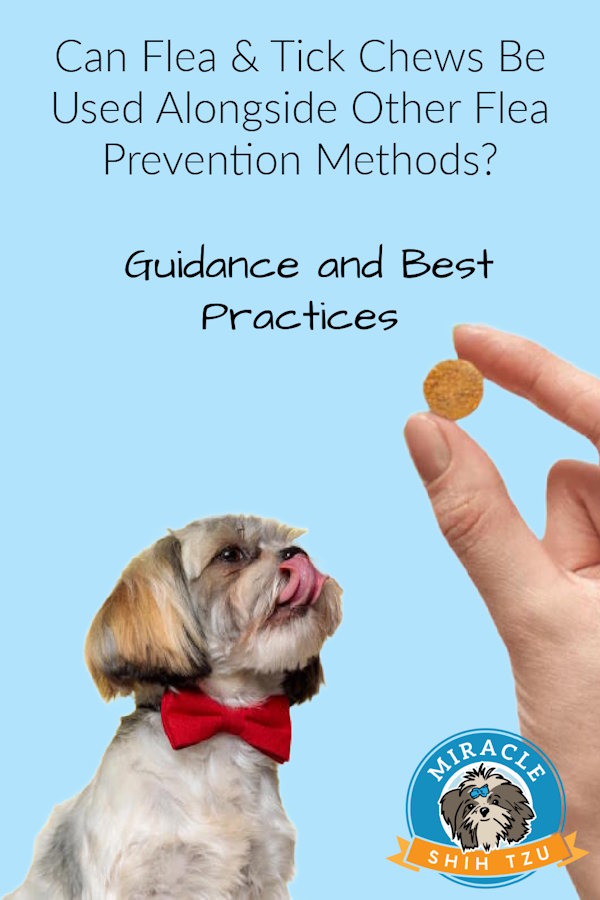Can Flea & Tick Chews Be Used Alongside Other Flea Prevention Methods? Expert Guidance and Best Practices
Many pet owners look for safe and easy ways to protect their dogs from fleas and ticks. With so many choices like topicals, collars, and dog chews for flea and tick control, it can be confusing to know what's best or if they can be used at the same time. Mixing different flea prevention methods is usually not recommended because it may raise the risk of side effects.

Understanding the risks and benefits of each method helps keep dogs safe and healthy
Some pet owners still wonder if using chews together with other products could give added protection. For example, some choose dog chews for flea and tick control while considering if collars or spot-on treatments can be used as well.
Compatibility of Flea & Tick Chews With Other Prevention Methods
Flea and tick chews can sometimes work with other flea control products, but not all combinations are safe. Using more than one type of medication may increase the risk of side effects or provide better coverage, depending on the types chosen.
Safe Combinations for Flea Control
Some products focus only on fleas, while others only target ticks. In certain cases, a chew for fleas can be used with a separate tick prevention product if each addresses only one type of pest. For example, using a chew for fleas with a tick collar may sometimes be allowed, but only if each product has different active ingredients.
Use this checklist before combining products:
- Check if the active ingredients are different.
- Confirm one product is only for fleas and the other is only for ticks.
- Make sure both products do not have warnings against combining with others.
For most pets, one product is enough. Extra protection is not always safer or more effective.
Potential Risks of Double-Dosing
Using two flea products that contain the same or similar ingredients can lead to double-dosing. This can make a pet sick. Signs of overdose include vomiting, shaking, drooling, or trouble walking. Even a small extra dose can be dangerous in smaller animals.
Most flea and tick products are measured by weight and can be toxic if doubled. Combining two full treatments is not recommended unless a veterinarian says it is okay. Negative side effects can range from mild to life-threatening. It is always safer to avoid using similar medications together unless a pet professional advises it.
Consulting Your Veterinarian for Guidance

A veterinarian should always guide pet owners on what is safe for their pets. They can suggest which products might work together or if combining treatments is needed. Every animal is different and may react in unique ways to certain medicines.
Pet owners should always bring product packaging or write down the names of any flea or tick products being used. This helps the veterinarian assess any possible interactions. Asking questions and sharing any side effects is important for keeping pets healthy. Pet owners should never mix products without asking an expert first.
Considerations for Using Multiple Flea Prevention Products
Combining different flea prevention products for pets might seem helpful, but it comes with important considerations. Paying attention to how products might interact and watching pets for side effects is necessary for their safety.
Product Interactions and Safety
Before giving a dog more than one flea prevention product, it is important to know how these medicines work together. Some flea prevention chews and spot-on treatments use similar ingredients. When combined, this can lead to a stronger effect or even a harmful reaction.
Combining treatments can also increase the risk of overdosing, which may cause vomiting, drooling, or tremors. Most animal health experts recommend using only one type of flea prevention product at a time unless a veterinarian advises otherwise.
Some products are only designed to target certain pests, while others cover both fleas and ticks. Always check ingredient lists and talk to a veterinarian to reduce the chance of an unsafe combination. Following the recommended dosing schedule and directions on packaging helps avoid problems.
Monitoring for Side Effects
After starting a new flea prevention routine, closely watch the animal for any signs of discomfort. Common side effects may include scratching, redness of the skin, hair loss, vomiting, or unusual behavior. Early signs of a reaction can appear within hours or days of use.
It is helpful to write down the date and type of products used. This record makes it easier to spot a pattern if side effects happen more than once. If symptoms like heavy drooling, loss of appetite, weakness, or severe itching show up, it may be necessary to call a veterinarian right away.
Noticing and responding quickly to any side effects helps prevent worse problems. If a veterinarian is consulted, provide details about all products given and the timing of symptoms for accurate advice.
Frequently Asked Questions
Are flea and tick chews safe for my dog?
Yes, most flea and tick chews are FDA-approved and safe when used as directed. However, side effects like vomiting, lethargy, or itching can occur in some dogs. Always consult your veterinarian, especially if your dog has health conditions or is on other medications.
How often should I give my dog a flea and tick chew?
Most chews are given once a month, but some (like Bravecto) last up to three months. Always check the product label and follow your vet's instructions to maintain consistent protection.
Can puppies take flea and tick chews?
Yes, but age and weight matter. Some brands are safe for puppies as young as 8 weeks and weighing at least 2 lbs, while others may require the dog to be older or heavier. Read the label carefully or ask your vet for advice tailored to your pup.
Are natural flea and tick chews effective?
Natural chews can help repel pests but often lack the killing power of prescription medications. They’re a great option for mild infestations or for dog owners who prefer a more holistic approach. For heavy flea or tick problems, pharmaceutical-grade chews are more reliable.
What if my dog won’t eat the chew?
Some dogs are picky! Try hiding the chew in a favorite treat or meal. If that doesn’t work, ask your vet if there’s an alternative form (like a tablet or topical). Some brands also offer flavored versions to increase palatability.
What should I do if my dog has a bad reaction?
Stop using the chew immediately and contact your veterinarian. Monitor for symptoms like tremors, excessive drooling, or severe lethargy. While adverse reactions are rare, they should always be taken seriously.
Conclusion
People often wonder if it's safe to use flea and tick chews with other types of flea prevention. It is sometimes possible, but safety depends on the combination of treatments and the health of the pet.
Every method has its own instructions, so it is important to read the product labels closely. Using two of the same kind, such as two insecticide-based products, is usually not advised and may cause side effects.
It’s best to talk with a veterinarian before mixing different flea prevention treatments. This helps avoid giving too much medicine and keeps pets safer.
Flea and Tick Chews: Pin for Future Reference
"Hi, I'm Janice Jones, a former veterinary technician and Shih Tzu expert with over 40 years of experience with the breed. Through Miracle Shih Tzu, I combine my medical background and extensive breed knowledge to provide reliable, practical advice for Shih Tzu owners. My mission is to help you give your Shih Tzu the happiest, healthiest life possible through evidence-based information and real-world solutions. Whether you're new to the breed or a seasoned owner, you'll find trusted guidance here for all aspects of Shih Tzu care.
I hold an undergraduate degree in Psychology with a minor in biology, Early Childhood Education, and Nursing, and a Master's in Mental Health Counseling.




